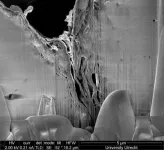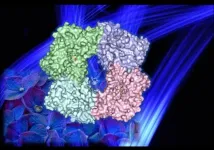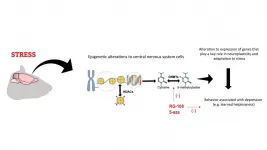Scientists develop new approach to understanding massive volcanic eruptions
Numerical model gives scientists a new tool for estimating the magnitudes of large explosive eruptions occurring thousands of years ago.
2021-01-04
(Press-News.org) A geosciences team led by the University of South Florida (USF) has developed a new way to reconstruct the sizes of volcanic eruptions that occurred thousands of years ago, creating a first-of-its kind tool that can aid scientists in understanding past explosive eruptions that shaped the earth and improve the way of estimating hazards of future eruptions.
The advanced numerical model the USF team developed allows scientists to reconstruct eruption rates through time by estimating the dimensions of the umbrella clouds that contribute to the accumulation of vast deposits of volcanic ash. The research is published in the new edition of the Nature Journal, Communications, Earth and Environment.
The research, which was used to decipher the 2,500-year-old eruption of a volcano in Ecuador, was led by USF doctoral candidate Robert Constantinescu in collaboration with USF colleagues Research Associate Laura Connor, Professor Chuck Connor, Associate Professor Sylvain Charbonnier, doctoral alum Alain Volentik and other members of an international team. USF's Volcanology Group is one of the world's leading centers of volcano science and hazard assessment.
When large explosive eruptions occur, they form laterally spreading umbrella clouds into the stratosphere, facilitating the transport of fine-grained ash over hundreds of miles that settles and covers large swaths of land.
Current technology allows scientists to observe ash clouds. However, past eruptions are characterized based on the geological interpretation of their tephra deposits - the pieces and fragments of rock ejected into the air by an erupting volcano. By estimating the erupted volume and mass, plume height, umbrella cloud dimensions and other characteristics, the scientists are able to understand and characterize the volcanic eruptions, therefore improving the forecast of future events.
Using a series of field techniques combined with statistical and numerical modeling, volcanologists extract information from the deposits in order to characterize and classify an eruption on one of the most commonly used scales, the Volcanic Explosivity Index (VEI). Until now, the most sought-after information is the eruption column height and the total erupted mass or volume, Constantinescu said.
But over time, deposits erode and can provide an uncertain picture of older eruptions. Also, current models have been limited in that they assume all volcanic eruptions created mostly vertical plumes, Constantinescu said, and don't account for large explosive eruptions that form laterally spreading umbrella ash clouds.
The USF team's work shows that it is the dimensions of the umbrella clouds that is the telling factor in reconstructing past large explosive eruptions.
"The better we can reconstruct the nature of past eruptions from deposit data, the better we can anticipate potential hazards associated with future explosive eruptions," the team wrote in the new journal article.
The researchers propose updating the VEI scale with the umbrella cloud dimensions, which can now be easily estimated using the mathematical models they've developed.
The researchers applied their model to the tephra deposit of the eruption of Pululagua, a now dormant volcano about 50 miles north of the capital city of Quito. Ecuador is considered one of the world's most hazardous countries for volcanoes. The volcano last erupted an estimated 2,500 years ago and the area is now a geobotanical reserve renowned for its biodiversity and lush green landscape.
There are about 1,500 potentially active volcanoes worldwide, in addition to those that lurk beneath the world's oceans. In 2020, there were at least 67 confirmed eruptions from 63 different volcanoes, according to the Smithsonian Institution Global Volcanism Program.
"If in modern times the umbrella clouds of large eruptions are easily observed, we now have the ability to estimate the umbrella clouds of past eruptions," Constantinescu said. "Our numerical model enables us to better characterize past volcanic eruptions and inform models for future hazard assessment."
INFORMATION:
The USF team was joined in the research by Aurelian Hopulele-Gligor of Cluj-Napoca, Romania; Costanza Bonadonna of the University of Geneva; and Jan M. Lindsay of the University of Auckland. The research was funded in part by the National Science Foundation.
[Attachments] See images for this press release:

ELSE PRESS RELEASES FROM THIS DATE:
2021-01-04
CHICAGO --- While many physicians benefit from social media by networking with potential collaborators or interfacing with patients, a new study from Northwestern University and the University of Chicago found many physicians also report being sexually harassed and personally attacked on these platforms on the basis of their religion, race or medical recommendations.
Although the data were collected before the COVID-19 outbreak, the findings highlight the intensity of online harassment before the pandemic, which has only intensified since the spring, the study authors said.
"If anything, our data is likely an underestimate of the true ...
2021-01-04
LOS ANGELES -- A growing number of women forgoing reconstruction after a mastectomy say they're satisfied with their choice, even as some did not feel supported by their physician, according to a study led by researchers at the UCLA Jonsson Comprehensive Cancer Center.
The study, published in the Journal Annals of Surgical Oncology, surveyed 931 women who had a unilateral or bilateral mastectomy without current breast mound reconstruction to assess the motivating factors for forgoing the procedure and to measure whether surgeons provided adequate information and support for "going flat."
Out of the women surveyed, 74% were satisfied with their outcome and 22% experienced "flat denial," where the procedure was not initially offered, the ...
2021-01-04
Of the 5,300 children enrolled in the Ohio Behavioral Health Juvenile Justice Initiative since 2006, 21% reported that someone close them had been murdered in the past year. Nearly half of the boys and more than a quarter of the girls in the program have both a substance abuse and mental health disorder.
But there's good news, too: From 2017 through 2019, 81% of the participants--aged 10 through 17--successfully completed the state's juvenile diversion program, and data indicated that 79% of youth reduced their contact with police while in treatment.
Those findings are from a new detailed evaluation of the Ohio Behavioral Health Juvenile Justice Initiative (BHJJ) by researchers at the Jack, Joseph and ...
2021-01-04
Boulder, Colo., USA: Europe's largest gas field, the Groningen field in the Netherlands, is widely known for induced subsidence and seismicity caused by gas pressure depletion and associated compaction of the sandstone reservoir. Whether compaction is elastic or partly inelastic, as implied by recent experiments, is key to forecasting system behavior and seismic hazard.
Bart Verberne and colleagues sought evidence for a role of inelastic deformation through comparative microstructural analysis of unique drill-core, recovered from the seismogenic center of the field in 2015, 50 years after gas production started, versus core recovered before production (1965). Quartz grain fracturing, crack healing, and stress-induced Dauphiné twinning are ...
2021-01-04
BOSTON - A long-running debate over how an important gene-silencing protein identifies its targets has been resolved by researchers at Massachusetts General Hospital (MGH). Their findings, reported in Nature Structural and Molecular Biology, also explain certain mysteries about the behavior of this protein, known as Polycomb repressive complex 2 (PRC2).
PRC2 helps regulate whether genes are active ("on) or silent ("off"). PRC2's role in gene silencing is critical throughout the lifespan, from embryo formation to old age. For example, PRC2 determines whether genes that suppress the growth of malignant tumors are turned on or off, which has made it the focus of pharmaceutical companies ...
2021-01-04
If you've ever had a bad case of jet lag, you know how a disruption to your body's circadian rhythm makes it difficult to function. Molecular circadian "clocks" exist in cells throughout the body, governing more than just sleep and wake cycles - they are crucial to many aspects of human health. For more than a decade researchers have been trying to figure out what makes them tick, in search of new insights into diseases like Alzheimer's, cancer and diabetes.
Until now, that research has focused on what is known as clock genes, which encode proteins that drive oscillating cycles of gene expression affecting physiology and behavior. But research just published in the Proceedings of the National Academy of Sciences reveals the discovery ...
2021-01-04
Plants can perceive and react to light across a wide spectrum. New research from Prof. Nitzan Shabek's laboratory in the Department of Plant Biology, College of Biological Sciences shows how plants can respond to blue light in particular.
"Plants can see much better than we can," Shabek said.
Plants don't have dedicated light-detecting organs, like our eyes. They do have a variety of dedicated receptors that can sense almost every single wavelength. One such are the blue light photoreceptors called cryptochromes. When the cryptochrome detects an incoming photon, it reacts in a way that triggers a unique physiological response.
Cryptochromes probably appeared billions of years ago with the first living ...
2021-01-04
By Karina Ninni | Agência FAPESP – Treatment of depression faces two main challenges. The first is that almost 50% of patients do not respond well to existing antidepressants. The second is that conventional medications take a relatively long time – around three to five weeks – to have the desired effect. A group of researchers affiliated with the University of São Paulo (USP) in Brazil set out to tackle the second problem by using epigenetic modulators to try to “erase” the consequences of stress. Epigenetic mechanisms are part of a complex system that controls how and when genes are switched on or off.
Exposure to stress, a key trigger of depression, alters certain epigenetic markers in the brain. Many of these alterations ...
2021-01-04
The coronavirus pandemic is creating a large spike in significant psychological distress among Americans, with the first month of the pandemic causing as much distress in the same number of individuals that experienced it during the whole previous year, according to a new RAND Corporation study.
Findings from the first longitudinal study of psychological distress during the pandemic show that among a representative sample of Americans, more than 10% reported experiencing symptoms of significant psychological distress during April and May of 2020 -- the same amount they reported experiencing over an entire year during a survey conducted a year earlier.
The study also found that people with distress prior to the ...
2021-01-04
Scientists have long been aware of the dangerous overuse of antibiotics and the increasing number of antibiotic-resistant microbes that have resulted. While over-prescription of antibiotics for medicinal use has unsettling implications for human health, so too does the increasing presence of antibiotics in the natural environment. The latter may stem from the improper disposal of medicines, but also from the biotechnology field, which has depended on antibiotics as a selection device in the lab.
"In biotech, we have for a long time relied on antibiotic and chemical selections to kill cells that we don't want to grow," said UC Santa Barbara chemical engineer Michelle ...
LAST 30 PRESS RELEASES:
[Press-News.org] Scientists develop new approach to understanding massive volcanic eruptions
Numerical model gives scientists a new tool for estimating the magnitudes of large explosive eruptions occurring thousands of years ago.



